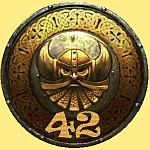
Kharne Encyclopedia

 |
Kharne Encyclopedia |
 |


 Dungeon Rooms |
DUNGEON INVENTORY |
 Dungeon Items |
|
These items can be found in certain dungeon rooms. They can not be removed from their location. |


|
40I - ALTAR A feature common to most temples and also found in many dungeons is the altar. This usually takes the form of a massive stone block upon which a variety of religious symbols have been carved. The smallest weigh in the region of several tons and they obviously can not be moved by any normal means. They have small compartments carved in them for the storage of religious implements or artefacts. These compartments are often carefully concealed so that they will not be found even if the altar is carefully searched. |
 © nxcache.nexon.net |


|
402 - THRONE A throne is a special chair carved from solid stone or occasionally from wood. It is far too heavy to move. It looks as though it was once decorated with gems and rare metals but these have been prised away and stolen long ago. Nevertheless the throne still looks very impressive and was obviously built for an important person. |
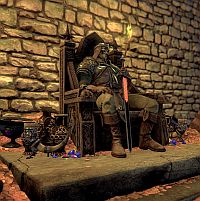 © lorentzen.se |

|
403 - STATUE Statues are a regular feature in all dungeons. They come in all shapes and sizes, depicting people, animals or even monsters. The only feature in common is that they are far too heavy to move by any normal means. They tend to be in poor condition owing to the years of neglect and abuse suffered since being created. |
 © Morrowind |

|
404 - PEDESTAL Pedestal, plinth, platform - all are similar, a block or short pillar of stone built for the sole purpose of having something else put on top of it, usually for display purposes. As a general rule, the item being displayed tended to be quite valuable so it is no surprise that most have been stolen already. The pedestal itself is far too heavy to be moved, let alone carried away. |

|
405 - COLUMN These stout pillars of stone are an essential feature of dungeon architecture. Stone ceilings are enormously heavy, especially when they have hundreds of feet of rock above them. Without a few columns in the right places it would not be long before the whole dungeon collapsed. They are especially important in regions susceptible to volcanic activity. They are occasionally used for ornamental purposes too as they can look quite impressive. Even if not holding the ceiling up, columns are far to big to be moved in any way. |
 |

|
406 - SECRET COMPARTMENT For obvious reasons, most people in possession of treasure are keen to prevent anyone else from getting their hands upon it. There are several ways to keep items safe. Some keep them locked in treasure vaults, some hire guards and others use secret compartments. The advantage of secrecy is of course the low cost. The only expense is a craftsman to build the compartment and even this can be avoided as it is common practise to kill the craftsman to keep the secret a secret. The same applies to the lock smiths occasionally employed to create traps around the compartment for extra protection. Secret compartments can be concealed in walls, floors, altars, thrones, or just about anything else you can think of. |
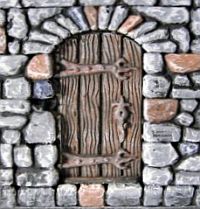 © Hirst Arts Modular Dungeon |

|
407 - IDOL These are statues of a religious nature, usually found in underground temples or shrines. They depict the physical form of a god or sometimes the spiritual beings which serve the gods. For example in a shrine of Fleyshur you might expect to find a statue of Fleyshur, a balrog or possibly just an imp, depending upon the importance of the the shrine. As with ordinary statues they are completely unmovable. They do tend to be in a somewhat better state than most statues however. Ordinary dungeon creatures tend to show respect to the gods, no matter what their alignment. Where religion is concerned, big is beautiful in Kharne. The bigger the idol, the greater respect is shows for the god depicted. Unlike smaller idols, a giant idol always represents a god and never a minor spirit or demonic being. Giant idols are truly vast, weighting hundreds, possibly even thousands of tons. Despite their great age, they are usually in excellent condition.Partly due to the respect with which they are treated and partly because there is simply nothing big enough to cause them any serious damage. How they were constructed in the first place is a complete mystery. |
 © ak0.pinimg |

|
409 - PEW Pews can be found in religious buildings all over the world (except of course in Novala's shrines where cushions and soft couches are more common) and the underground shrines found in dungeons are no exceptions. The only difference is that they are totally rotten from years of neglect and generally useful only as firewood. A few are still strong enough to be sat upon but they are too heavy to be moved to block doors, form barricades, or to be used as battering rams. |
 © theminiaturespage.com |

|
4I0 - CAGE Many dungeons and ruins contain rooms which have been sectioned off with strong metal bars embedded in the walls, ceilings and floors. Whether they were used as animal cages or to imprison more intelligent beings is now impossible to say except in a few cases where the skeletal remains of the previous occupants tell their own tale. These barred cells were built to last and even though the individual bars are often heavily rusted they are still far too solid to be moved. |
 © ak0.pinimg |

|
4II - TAPESTRY Dungeons were not always the dank and dismal places which they have now become. In most cases they were once pleasant and comfortable places in which to live and the occupants spent considerable sums of money decorating the halls and chambers to suit their tastes. Many opted for vast tapestries to cover the stone walls. These have obviously suffered the ravages of time and are now too rotten to move and too damp to burn. The colours and patterns have faded to the extent that it is no longer possible to determine what the tapestry once represented. |
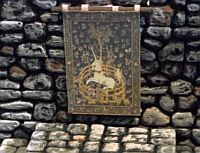 © Hirst Arts Modular Dungeon |

|
4I2 - BUTTON The engineers and artificers of bygone days were often highly skilled, and complex (sometimes magical) mechanisms could be set in motion by the touch of a single button. This can be a very risky business of course as there is generally no way of telling what a button will do until after it has been pressed. Many can open doors or secret compartments but others will trigger devastating and lethal traps. |
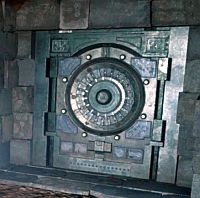 © i.ytimg.com |

|
4I3 - LEVER Levers can be to perform a multitude of actions. Some will trigger, or reset a trap, others will lock or open concealed doors. Some may do nothing at all though this is usually an indication that the mechanism they once controlled is no longer functional. There is often no way to tell what a lever will do without pulling it but only a foolish adventurer would fail to investigate it as closely as possible before using it. The lever itself may even be trapped in some way. |
 © miniset.net |

|
4I4 - FIREPLACE Like all dwelling places, most dungeons or ruins will have fireplaces in many of the rooms. Indeed the type of fireplace can give some idea of the room's original purpose. Wide grates with stoves or spits obviously indicate a kitchen whereas grand mantelpieces and wide hearths are probably indication of a great hall or throne room. The chimney passages are generally too small to permit characters to climb up them. |
 © shutterstock |

|
4I5 - COFFIN The custom of burying the dead in coffins is widely used on Kharne by the followers of all gods. The ceremony which occurs during burial will vary quite a bit but the end result is a body in a box in a hole. Occasionally the coffin will be stored in a crypt if the deceased came from a wealthy background and ancient coffins can be found in some dungeon chambers. It is not unusual to find the coffins empty as many dungeons denizens have few scruples about what or who they eat. The coffins themselves are too heavy to move. |
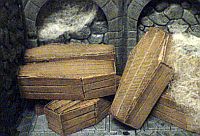 © The Lost and the Damned |

|
4I6 - SARCOPHAGUS The burial boxes of the wealthy are often far more impressive than a simple wooden box. They will be made of rare woods and metals and the box lid will be carved to represent an idealised portrait of the contents. It is not uncommon for the deceased's most treasured possessions to buried in the sarcophagus with them (though these are often stolen by grave-robbers). Sarcophagi are extremely heavy and can not be moved. |
 © ak0.pinimg |

|
4I7 - FOUNTAIN Water has always been seen as a symbol of life and in the dismal depths of a dungeon the splashing water of a fountain is a delightful reminder of the real world far above. Unfortunately many fountains are no longer working and they now resemble nothing more than a stagnant pool of filthy water, covered in slime and algae of one type or another. Of the few that do still work, most are fed by natural springs but a few are controlled by subtle magic. |
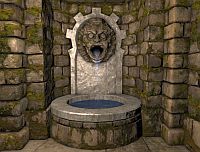 © Legend of Grimrock |

|
4I8 - WELL Most dungeons were built with defence and security in mind and the possibility of siege by forces unknown was always something to be considered. Most dungeons were built with at least one well to supply water and usually there were several. In many cases they are now empty or the water at their bottom is foul but a few do still hold fresh water. Some may even hold concealed treasure. |
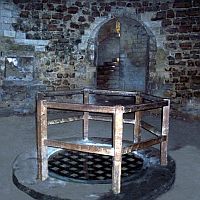 © Myths and Legends |

|
449 - POOL OF WATER Pools are a valuable source of water for groups spending long periods of time underground. In dungeons or lairs there will usually be at least one group of monsters lurking somewhere nearby. Aquatic or amphibious monsters may even be living in the pool, ready to attack a careless character taking a drink. Pools may also be trapped or poisoned. |
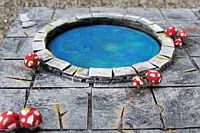 © littlesoldiers.net |

|
458 - TRAPS In older versions of the game, item# 458 was reserved for a teleporter, which was never implemented. However, teleporter are on of the traps, one might encounter in a dungeon. Most common are pitfalls, which are sometimes equipped with spikes. Also common are tripwires, releasing arrows or bolts. The injuries sustained by these traps are normally not life threatening, but an already injured or poorly armoured adventurer can get seriously hurt. Teleporter traps can be found in the lower levels of dungeons. They do not cause bodily harm, but transport the entire party to a different room. This can seriously affect a carefully laid out exploration plan. |
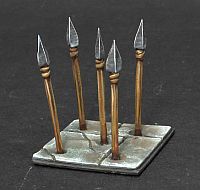 © miniset.net |

|
459 - RACK This massive wooden construction is one of the more effective torture devices used by inquisitors of the evil sects. They can also be found in ruins or dungeons, often with the grisly remains of victims still attached. Monster groups with lairs nearby will sometimes keep them in good working condition so that they can 'play' with their victims, before eating them. |
 |

|
460 - IRON MAIDEN A device developed to inflict a rather unpleasant form of execution. They are usually about three feet across and deep and about seven feet high. They look like an upright coffin, with long metal spikes set in the base and lid. Being made of iron they are extremely heavy and impossible to move. |
 |

|
46I - STOCK A form of non-violent punishment common to most towns are the stocks. These wooden devices have holes for heads, arms, and occasionally legs. Criminals locked in the stocks are held immobile and provide excellent entertainment for anyone passing through the town square where they are usually built. On market days, towns will have competitions for the most accurate throwing of rotten fruit or offal, with the occupant of the stocks as a target of course. They can also be found in dungeons. |
 |

|
462 - SHACKLE Shackles are a common feature of dungeons everywhere. They are used to restrain, or punish, violent or troublesome prisoners. They consist of stout metal bands for hands, feet and necks, connected to a wall by heavy chains and metal staples. Removing them is not possible, and they would be of little or no value anyway. Examples found in ruins or abandoned dungeons are usually pitted with corrosion. |
 |

|
463 - MANACLE These restraining devices are found where ever a prison is built. Strong metal bands are pinned to a stone wall and used to enclose a prisoners hands or feet. As the manacles are fixed directly to the wall, the prisoner has absolutely no freedom of movement. They can not be removed from the wall to which they are attached and are of little value in any case. |
 |


 Dungeon Rooms |
 Dungeon Items |


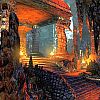 Back to Dungeon Guide |
Everything on these pages is related only to the fantasy game world of Quest and has no relations whatsoever to the real world and real people, places or events!
 All pictures are borrowed from other not-game-related sites for illustration and entertainment purpose only. Every picture is credited with copyright information and linked to its original page. |
 Back to Kharne Encyclopedia |

